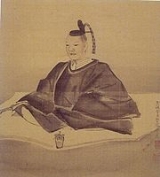
Kobori Masakazu
Encyclopedia

Tokugawa Ieyasu
was the founder and first shogun of the Tokugawa shogunate of Japan , which ruled from the Battle of Sekigahara in 1600 until the Meiji Restoration in 1868. Ieyasu seized power in 1600, received appointment as shogun in 1603, abdicated from office in 1605, but...
.
In 1604, Kobori received as inheritance a 12,000-koku fief in Ōmi Province
Omi Province
is an old province of Japan, which today comprises Shiga Prefecture. It was one of the provinces that made up the Tōsandō circuit. It is nicknamed as .Lake Biwa, Japan's largest lake, is located at the center of the province...
at Komuro. He excelled in the arts of painting, poetry, flower arrangement
Ikebana
is the Japanese art of flower arrangement, also known as .-Etymology:"Ikebana" is from the Japanese and . Possible translations include "giving life to flowers" and "arranging flowers".- Approach :...
, and garden design. His accomplishments include garden designs for the Sento Imperial Palace
Sento Imperial Palace
The Sentō Imperial Palace or Sentō-gosho is a large garden in Kyoto, Japan, formerly the grounds of a palace for retired emperors...
and Katsura Imperial Villa
Katsura Imperial Villa
The , or Katsura Detached Palace, is a villa with associated gardens and outbuildings in the western suburbs of Kyoto, Japan...
(Kyoto), Kōdai-ji
Kodai-ji
, formally identified as , is a temple of the Rinzai school of Zen Buddhism in Higashiyama-ku, Kyoto, Japan—the largest subtemple of the Kennin-ji branch. It was established in 1606 by Nene , the widow of Toyotomi Hideyoshi, to pray for her late husband...
, Sunpu Castle
Sunpu Castle
was a Japanese castle in Shizuoka City, Shizuoka Prefecture in Japan. The sobriquet of this feudal fortress was the "Castle of the Floating Isle." It was also referred to as or .-History:...
, the Nagoya Castle
Nagoya Castle
is a Japanese castle located in Nagoya, central Japan. During the Edo period, Nagoya Castle was the center of one of the most important castle towns in Japan—Nagoya-juku— and it included the most important stops along the Minoji, which linked the Tōkaidō with the Nakasendō.-History:In...
keep, Bitchū Matsuyama Castle
Bitchu Matsuyama Castle
, also known as Takahashi Castle, is a castle located in Takahashi, Okayama Prefecture, Japan. It is not to be confused with Matsuyama Castle in Matsuyama, Ehime Prefecture. Bitchū Matsuyama Castle is notable as the castle with the highest elevation above sea level in Japan.- History :The castle...
, and the central enceintes of Fushimi Castle
Fushimi Castle
', also known as Momoyama Castle or Fushimi-Momoyama Castle, is a castle in Kyoto's Fushimi Ward. The current structure is a 1964 replica of the original built by Toyotomi Hideyoshi.-History:...
, Nijō-jō
Nijo Castle
is a flatland castle located in Kyoto, Japan. The castle consists of two concentric rings of fortifications, the Ninomaru Palace, the ruins of the Honmaru Palace, various support buildings and several gardens...
(Kyoto), and Osaka Castle
Osaka Castle
is a Japanese castle in Chūō-ku, Osaka, Japan.Originally called Ozakajō, it is one of Japan's most famous castles, and played a major role in the unification of Japan during the sixteenth century of the Azuchi-Momoyama period.-Description:...
.
Kobori though was known best as a master of the tea ceremony
Japanese tea ceremony
The Japanese tea ceremony, also called the Way of Tea, is a Japanese cultural activity involving the ceremonial preparation and presentation of matcha, powdered green tea. In Japanese, it is called . The manner in which it is performed, or the art of its performance, is called...
. His style soon on became known as "Enshū-ryū". In light of Kobori's ability, he was tasked with teaching the 3rd Tokugawa shogun
Tokugawa shogunate
The Tokugawa shogunate, also known as the and the , was a feudal regime of Japan established by Tokugawa Ieyasu and ruled by the shoguns of the Tokugawa family. This period is known as the Edo period and gets its name from the capital city, Edo, which is now called Tokyo, after the name was...
, Tokugawa Iemitsu
Tokugawa Iemitsu
Tokugawa Iemitsu was the third shogun of the Tokugawa dynasty. He was the eldest son of Tokugawa Hidetada, and the grandson of Tokugawa Ieyasu. Iemitsu ruled from 1623 to 1651.-Early life :...
the ways of tea ceremony. In this role, he designed many tea houses including the Bōsen-seki in the subtemple of Kohō-an at the Daitoku-ji
Daitoku-ji
is a Buddhist temple, one of fourteen autonomous branches of the Rinzai school of Japanese Zen. It is located in Kita-ku, Kyoto, Japan. The "mountain name" , who is known by the title Daitō Kokushi, or "National Teacher of the Great Lamp," that he was given by Emperor Go-Daigo...
, and the Mittan-seki at the Ryūkō-in of the same temple.

